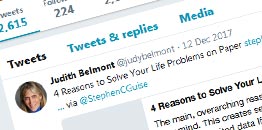In my clinical psychology graduate program with its psychoanalytic orientation back in the 70‘s, I was taught that therapy largely was focused on uncovering how your past was still present in everyday life. The mindset at the time was that only by shedding light on deep seated issues can a person move past what had made them stuck, with increased insight and understanding. I only learned about Cognitive Behavior Therapy after graduate school, and was amazed at how just changing one’s self talk one can really change lives and happiness quotient. However, in my practice i found that even was not enough. Insight into thinking patterns alone does not change things, especially if habits are deeply ingrained. Sometimes, “knowing better” does not mean that we can actually “do better.” If so, we would all be exercising regularly and trim and fit! For many clients, some no matter how much they identify their irrational thoughts and know how they can replace them with more rational ones, they remain stuck. Why? They have no new skills to act differently!
That is where the idea of psychotherapist as psycho-educator comes in. The role of the therapist is not just to listen, support and offer feedback and suggestions – it is also to teach!
Teaching does not mean telling! Rather, using learning tools such as handouts, worksheets, role playing, visualization, experiential activities and mini-lessons, counselors can be in a unique position to offer the “how tos” of making changes. For example, I have a life skills manual that I have made up of many of my best handouts and worksheets, and clients find that the between session “homework” offers them a chance to practice and reinforce the concepts learned in therapy.
Teaching life skills is not telling clients what to do – it is teaching them strategies that they have never learned in school or in life. This proactive approach empowers clients with tools for life, and helps them experience change constructively. Beyond talking is “doing” and you can offer clients vital opportunities to experience and try out new behaviors, thoughts and skills. Experiential exercises might be able to break through even the most strongly erected unhealthy habits and defenses.
As Confucius said so aptly, “Teach me and I will forget, show me and I will remember, involve me and I will understand.”
I use the term “self-help assignments” instead of homework, since homework might have negative connotations after years of schooling. Self-help assignments help clients be more proactive and responsible for their own growth and wellness. Self-Help assignment transform “what “ into “how.”
For example, one of my favorite handouts is one that compares the three type of communication, Assertive, Non-Assertive and Aggressive, and the reasons, characteristics and payoffs of each. To reinforce the learning, I have worksheets that clients do between sessions to turn aggressive or non-assertive examples into assertive examples. Replacing aggressive “you” statements with assertive “I” statements will give your clients a chance to practice what they have learned. I suggest they keep the handouts in a prominent place so they can refer to them regularly to learn new skills. The handouts and worksheets, and at times a “prop” that helps them stay “on target.” One “prop” is an elastic band that I ask some of my clients to keep on their wrists, and snap it gently each time that find themselves thinking or behaving in a negative manner.
Quick and easy activities can also be quite effective. The following is an example of an activity that you can do in your therapy sessions and is also great for groups, One simple exercise offers a convincing example of the importance of flexible thinking and being willing to see things from other points of view.
Clasp your fingers so that your fingers interlock. Which thumb is on top? In a group situation, about half have their left thumb on top and half the right, regardless of right or left-handedness. Note what is natural for some is not natural for another. This represents our perceptions— we think people see things the same way and by this “hands on” exercise we realize this is not true! Now shift your fingers in the opposite way (make sure all fingers are clasped differently, not just the thumbs). How does it feel? Common responses are “weird, strange, uncomfortable.” However, for some people it is effortless and natural! Thus, this “hands on” exercise serves as a metaphor of how we need to shift our thinking just so slightly in order to think in a different way. It can remind you also to be open minded when you listen to others, rather than expect for them to see things your way. Want an advanced version? Try the same exercise with folding your arms! Most people find this to make an even greater impact, as only about half of people fold their arms like you!
As you can see, counselors have a unique opportunity to help their clients not only with their support, empathetic listening and guidance, but actually serving as a life skills educator, empowering clients to help themselves!




Another excellent article. I think you have great skill in using metaphors to help clients learn. My use of metaphor, while teaching French, helped clients to ground the language concepts they were learning and tapped their creative self which carried over in their speaking skills.
Thank you again for the “hands-own” metaphors and the article in general.
Carole Milan Danis, LICSW